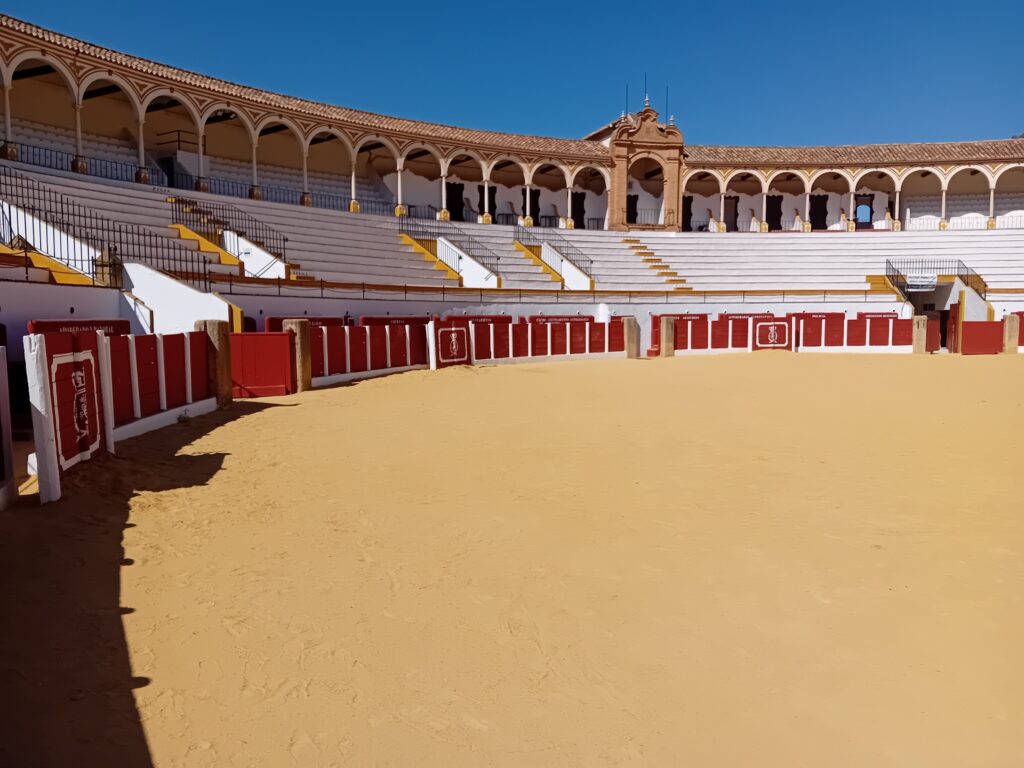
A visit to Antequera
5 Nights in Antequera
The Bullring – Plaza de Toros
Making good use of the wonderful weather, my family paid a visit to Antequera, an ancient city to the north of Malaga. One place we made sure to visit was the Bullring.
The Bullring of Antequera: Echoes of History Under Andalusian Sun
Nestled in the heart of Antequera, in the province of Málaga, stands a structure that is both a living stage of traditions and a keeper of history: the Plaza de Toros de Antequera. More than just a bullring, it embodies centuries of culture, architectural evolution, and modern reuse.
A Glimpse into the Past
The Antequera Bullring first opened its gates on 20 August 1848. (Andalucía Tourism) The urgency to build it—as local citizens wanted a permanent space for bullfighting rather than holding events in temporary squares—led to some expedient solutions. In particular, the high rows or tendidos altos were built in wood. (Turismo Antequera)
For well over a century, those wooden upper seating elements remained, weathering seasons and serving crowds, until 1980. At that point, the town council acquired the building and made plans for a full restoration.
Transformation & Architecture
In 1983, the decision was made: the Bullring would be renovated, both inside and out. The most visible changes started the following year (1984) with a new shadow door (puerta principal de sombra) built in the style of Antequera’s eighteenth-century alarifes (master craftsmen).
The rest of the façade was redesigned to harmonise with that monumental door: local brickwork paired with white plastered panels, a layout that blends solidity and elegance. Internally, the renovations included rebuilding the seating tiers, reducing the diameter of the ruedo (the arena), and replacing wooden upper structures and roofs with a loggia arcade of Tuscan white limestone columns and semicircular arches.
Traditional Arabic roof tiles (“teja árabe antigua”) were used on the roofs to give that classic Andalusian aesthetic over the loggia and along the façade walls.
The result? By the mid-1980s and early 1990s, the Plaza de Toros looked very different from its mid-19th-century origins—but arguably more beautiful to many eyes. Today it is considered one of Spain’s most attractive bullrings.
Today: More Than Just Bullfights
While bullfighting remains part of its calendar—especially during major local fairs— the Antequera bullring is much more versatile nowadays. (rondatoday.com)
Here are some of the modern features and uses that make it special:
- Exposición Permanente de Arte Taurino: On the top floor, there is a permanent exhibition (museum) of taurine art. It preserves photographs, posters, documents, and the local history of bullfighting—an opportunity to understand the tradition in broader social and artistic contexts.
- Restaurant under the stands: Under the stands, there is an entire restaurant (Lorenzo y María) that not only serves local Andalusian cuisine but is itself part of the ambience: corridors share the walls with bullfighting artefacts, decorative elements, and views towards the arena. It can host anything from romantic dinners to large celebrations or even shows.
- Capacity: The bullring can accommodate around 6,150 spectators. (Taurina de Buendia)
- Cultural events: Beyond bullfights, the plaza hosts concerts, festivals, opera performances, and other community cultural events. (Cadena SER)
Why It Matters
The Bullring of Antequera is significant for several reasons:
- Architectural blending: Its structure reflects Andalusian style, but also craftsmen’s tradition, classical columns, and Arab-roofed elements—a confluence of influences typical of the region.
- Historical continuity: From the mid-19th century to today, it has been in near continuous use, adapting to changing tastes, safety standards, and cultural expectations.
- Tourist and educational value: For visitors to Antequera (alongside the famous Dólmenes, Alcazaba, churches, etc.), the bullring adds a different texture—a hybrid of spectacle, artistry, and regional culture.
Tips for Visiting
- Visit the museum portion to get a deeper sense of the tan, the posters, the bullfighting world beyond the spectacle.
- Time your visit during local fairs (such as the Feria de Primavera in June, or the Feria de Agosto) when events are taking place.
- Even if you’re not interested in bullfighting, dining under the stands gives a unique perspective: architecture, atmosphere, and local flavours.
- Check opening times: the plaza is generally open from morning to early evening for tours and museum visits.
The Plaza de Toros de Antequera is more than stone, sand, and shadow. It’s a mirror of changing values, local identity, art, and architecture living side by side. For anyone who wanders through Andalucía, its walls tell stories worth pausing for.
Take the opportunity to explore inland Andalucia while you stay with us at Nerja Beach Holidays.
